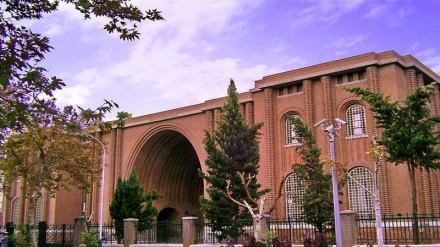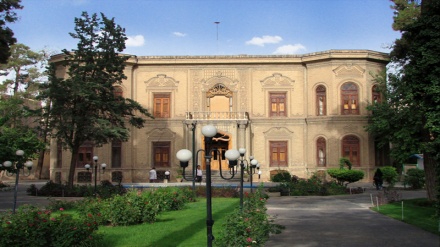Iran Your Attractive Destination (211)
Welcome to the 211th weekly episode of the series ‘Iran Your Attractive Destination’. Today, we introduce Mount Damavand.
As a reminder, last week we spoke of the historical monuments and the scenic landscapes of city of Damavand. Meanwhile, the name of this city is mainly a reminder of Mount Damavand which is the highest and most glorious pinnacle of Alborz Mountain Range. Mount Damavand is situated at a 75-km distance from Iran’s Capital, Tehran. The snow-tipped Mount Damavand, coupled with its natural, seasonal, and permanent lakes, mineral springs, plants, wild flowers, and heart-soothing tranquility has shaped and created a heavenly atmosphere in this region, displaying the beauties of nature to sight-seers, eco-tourists, and mountaineers. Although Mount Damavand is located in Mazandaran Province in northern Iran, Tehran Province is en route to majority of paths that lead to this mountain. Thus, today we speak of the glorious Mount Damavand, and its nearby unique scenic landscapes.
Alborz Mountain Range is situated in northern Iran. This mountain range is stretched parallel to southern coastlines of Caspian Sea toward Gorgan Valley in northeastern Iran. the further we get from the Caspian Sea coastlines toward the south, the altitude of mountains increase and therefore the moisture originating from the Caspian Sea is mainly kept within the northern foothills of this mountain range. Hence, in the northern side of Alborz Mountain Range a number of different plant species are observed. Alborz Mountain Range is geographically divided into northern, central, and southern mountains. The central mountains include Kandovaan, Laar, and Firouzkouh Mountains, which are stretched up to Mount Damavand and Laar Valley. This is the highest region of Alborz Mountain Range; in which the altitudes of some pinnacles surpass 4000 meters. Mount Damavand stands at the height of 5671 meters above the sea level and is the tallest pinnacle of Alborz Mountain Range. Mount Damavand is 4,000 meters higher than Reyneh Plain which is located at this mountain’s foothills.
Mount Damavand holds an especial status within Iran’s myths and legendary tales and has captured the attention of many as of ancient times. Story writers and epic poets, such as Ferdowsi, have authored tales, and composed poems about this mountain.
The travelers, who have visited Iran, have usually mentioned Mount Damavand in their travelogues, given that the beauty and glory of this pinnacle has drawn the attention of countless tourists.
The German diplomat and physician, Heinrich Brugsch, who has traveled to Iran nearly 1.5 centuries ago, after visiting the European countries, Egypt, Turkey, and Caucasus region, in his signature book, has detailed his ascension to Mount Damavand in the company of other mountaineers, while expressing astonishment about the beauties of this region. He admits that Iran’s mountains are much more beautiful than the mountains in Germany and the other European countries. Moreover, two other foreign mountaineers who have ascended Mount Damavand, have referred to the especial eagerness of Iranians toward mountaineering, and have pointed out that Mount Damavand is en route the journey from West to East, adding that this mountain is quite attractive for foreign mountaineers.
Mount Damavand is the highest mountain of Alborz Mountain Range and the tallest volcano in Asia, which is situated at a 35-km distance from the city of Damavand, in the vicinity of the city of Larijan. This mountain is in the shape of a regular cone, which is unique worldwide. Among the high mountains in the world, one can mention Mount Fujiyama in Japan with an altitude of 3770 meters, and Mount Ararat in Armenia, standing at 5000 meters above the sea level, which are in the shape of regular cones. However, the altitudes of both of these mountains are less than the height of Mount Damavand.
Based on estimations, this volcano has been dormant for nearly 100,000 years. The volcano’s crater is made of sulfur combinations. This pre-historic volcano has left behind pure sulfur pieces and particles at altitudes above 4000 meters, and is also home to a pond that is 100 meters in radius, and 30 meters in depth, which is usually covered with ice.
In the summer season, the temperature at Damavand Pinnacle stands at roughly -4 degrees Celsius around midday. There are a number of routes available for ascension of Mount Damavand. In fact, there are a total number of sixteen routes for ascension of this pinnacle; four of which are known as the main routes.
Damavand region is usually dry in the summer season. Hence, mountaineers usually make use of snowflakes and the glaciers on the foothills to provide water. At the altitude of 4000 meters, throughout the northern and northeastern parts of Mount Damavand, which are not exposed to direct sunray, there are several glaciers. Mountaineering throughout these regions is a highly difficult task, and only professional and seasoned mountaineers are capable of accomplishing this task within this route. In contrast, the southern route for ascension to Damavand Pinnacle is sunny, and therefore the climate is more appropriate in this route.
Mount Damavand foothills, from an altitude of 2000-3500 meters are fully covered with windflowers. These flowers blossom in spring and early summer seasons, granting magnificent beauty to these altitudes. Mount Damavand foothills are also home to a variety of plant species. Kabutarlee, Ask, and Gol-e Zard Caves are three of the tourist attraction sites on the foothills of Mount Damavand. Gol-e Zard Cave is located within the pretty Laar Plain, which is every year host to mountaineers who pass through this region for ascension of Mount Damavand. There are countless icicles in this cave. Its surface is covered with calcium carbonate, which usually glitters. There are also a number of cold water ponds in the cave. Although the surface of this cave is steeply sloped, movement inside this cave is an easy task. This cave and plain also capture the attention of innumerable eco-tourists, who visit this region.
Another tourist attraction site is Larijan region which maintains an attractive rural atmosphere and is home to warm water springs. One of the two warm water springs in this region contains sulfur and is situated 2380 meters above the sea level. The other warm water spring is located at a 3-km distance from the city of Larijan, at an altitude of 2450 meters.
There are also a number of mineral water springs in the mountainous and cold Ask Village.
Laar Plain is another tourist attraction site of Damavand, which maintains a moderate climate in the summer season.
In the southern side of Mount Damavand there is a frozen waterfall, which is one of a kind. This frozen waterfall is 7 meters in height and 3 meters in diameter. Its ice never completely melts away. In the summer season; due to direct sunrays, the temperature of this waterfall goes beyond 0 degrees Celsius in midday. However, round 4 pm the temperature once again falls below 0 degrees Celsius, thereby leaving this waterfall frozen as ever. This frozen waterfall is situated at an altitude of 5100 meters above the sea level, which is a record height for waterfalls in Middle East region.
MR/ME


